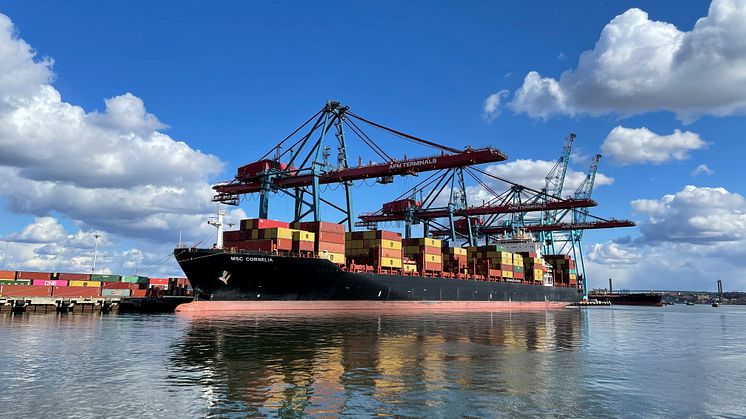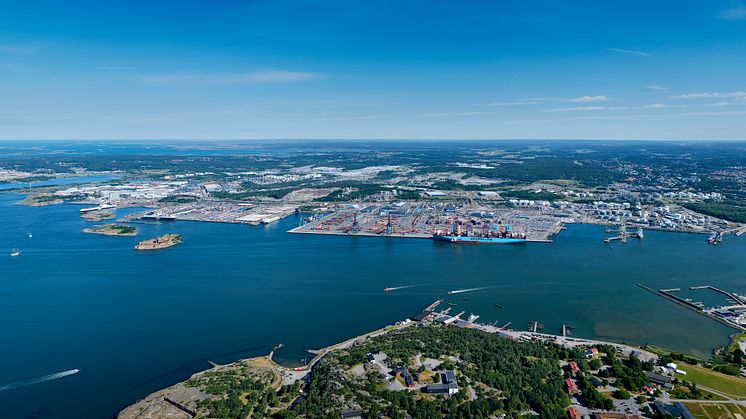
Press release -
Freight volumes continue to increase in the Port of Gothenburg
The Port of Gothenburg is growing in terms of volumes and enhancing its position as the guarantor of Swedish industry’s access to the world at large – this is reflected in the Port’s reported volumes for the first half of 2022. And despite warnings of an imminent recession, Elvir Dzanic, CEO of the Gothenburg Port Authority, believes there will be continued growth for the industrial sector into next year.
The vast majority of Swedish foreign trade takes place by sea. When it comes to trade with countries outside Europe, the most common method is to transport freight on container ships. At the Port of Gothenburg, which is the largest port in Scandinavia, 433,000 twenty-foot containers (TEU) were handled during the first half of 2022. This is a 5% increase compared with the same period in 2021.
The Port is also increasing its market share in Sweden. The Port currently accounts for 52% of the Swedish container market, compared with 48% at the beginning of last year.
“As a port, we’ve shown that we can provide Swedish industry with efficient service, despite the fact that the global logistics system continues to experience successive forms of disruption, causing problems in many ports. So it’s logical that Gothenburg is increasingly becoming the port of choice,” says Elvir Dzanic, CEO of the Gothenburg Port Authority.
The Railport Scandinavia railway system links the Port of Gothenburg with over 30 inland terminals at locations all over Sweden, and is one strong contributory factor behind the increase in container volumes in the Port. New locations were added to the system during the first half of 2022, while existing traffic has seen additional growth. All in all, container transport activities by rail to and from the Port have increased by 10% compared with the same period last year.
Increase in ro-ro, passenger numbers, cruise ships and energy products – but fewer cars
The ferry and cruise segments are seeing dramatic growth, as people continue to travel more as restrictions are eased. The number of ferry passengers increased by 197% in the first half of 2022, while calls by cruise ships increased from six to 25 during the same period.
The Port’s intra-European ro-ro traffic – which takes freight by road to and from the UK, Denmark, Germany, Poland, Norway and the Central European hubs at Gent and Zeebrugge in Belgium – increased by 3% during the first half of the year, as 295,000 ro-ro units were loaded or unloaded.
The automotive industry continues to struggle with component shortages and delivery problems. This is evident in, among other things, a drop in the number of new cars registered in the EU, which fell by 14% in the first half of 2022. The Port of Gothenburg is the biggest port in Sweden for cars and handled 122,000 vehicles during the same period, this too a drop of 14%.
The flow of energy products through the Port increased by 10% compared with the first half of 2022. It is above all refineries that have increased their production, although storage of crude oil is at stable levels.
The CEO believes in continued growth – despite threats of recession
While freight volumes at the biggest port in the Nordic region continue to grow in virtually all segments, many analysts believe that Sweden is nevertheless heading into a recession. The Swedish government is expecting a slowdown in global growth, and foresees major uncertainty for the Swedish economy ahead of next year. But Elvir Dzanic, CEO of the Gothenburg Port Authority, sees some different signals based on his own perspective.
“When we look to the future, talk to our customers and see what their order books look like, we have quite a positive view of the situation. No one is budgeting for lower volumes, either for the rest of this year or into next year. But having said that, I’m not oblivious to the world at large. We see the war in Ukraine and what’s happening with inflation, interest rates and electricity prices, just like everyone else. But the signals I’m picking up from the industrial sector don’t suggest reduced production volumes, rather the opposite,” says Elvir Dzanic, continuing:
“In addition to that, I’m convinced that we as a port will continue to win market shares. We’re continuing to create the conditions for reduced carbon dioxide emissions, increasing our digital capacity and broadening our shipping line network. This is important for us and it’s something that creates value for our customers.”
Port of Gothenburg’s freight volumes, Q2 and H1 2022
April–June 2022 | April–June 2021 | April–June comparison % | Jan–Jun 2022 | Jan–Jun 2021 | Jan–June comparison % | |
Containers, TEU | 221,000 | 207,000 | 7% | 433,000 | 411,000 | 5% |
Rail, TEU | 127,000 | 114,000 | 12% | 253,000 | 230,000 | 10% |
Ro-ro units | 148,000 | 148,000 | 0% | 295,000 | 287,000 | 3% |
New cars | 55,000 | 69,000 | -21% | 122,000 | 142,000 | -14% |
Passengers | 343,000 | 111,000 | 210% | 528,000 | 177,000 | 197% |
Cruise ship calls | 23 | 6 | 283% | 25 | 6 | 317% |
Energy products (million tonnes) | 5.5 | 4.8 | 14% | 11 | 10 | 10% |
Topics
Fact file: Port of Gothenburg
The Port of Gothenburg is the largest port in Scandinavia. Around 30% of Swedish domestic and foreign trade passes through the Port of Gothenburg and around 50% of all container traffic. The port is a full-service port, and offers industry guaranteed, climate-smart access to the whole world. Direct services to key markets ensure highly efficient, sustainable, and reliable transport 24 hours a day, 365 days a year. The focus is firmly on sustainability, innovation, and digitalisation in a concerted effort to maintain the ongoing development of climate-efficient freight transport and calls by vessels. With 25 rail shuttles offering daily departures, companies throughout Sweden and Norway have a direct, climate-neutral service to the Port of Gothenburg. The port operates energy product, vehicle, ro-ro, container, and passenger terminals and has 22,000 employees.
Follow us on:
Facebook
Instagram
LinkedIn
Twitter
www.portofgothenburg.com



